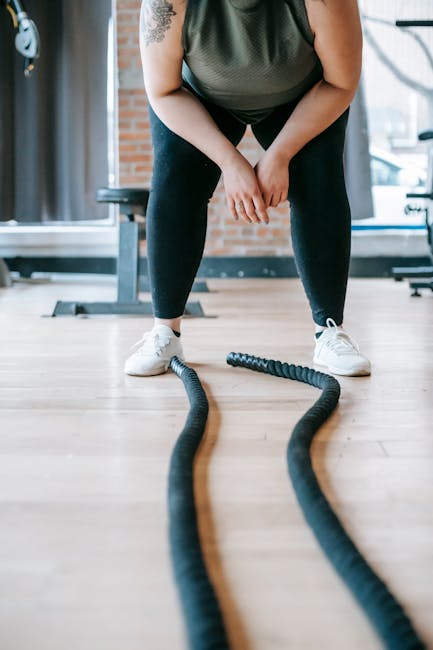Ladies and gentlemen, gather round, for today we embark on a journey of epic proportions. We are venturing into the world of weightlifting, where muscles bulge and sweat drips like a leaky faucet. But before we dive into the nitty-gritty of pumping iron, let’s discuss a crucial element- the humble weight lifting belt. This seemingly innocent accessory can make or break your workout, and we all know how tragic a broken workout can be. So, sit tight and prepare to be schooled on the proper technique of wearing a weight lifting belt, with a side serving of humor. Let’s do this!
Contents
- 1 1. Introduction: Understanding the Importance of Proper Technique in Weight Lifting
- 2 2. The Purpose and Benefits of Using a Weight Lifting Belt
- 3 3. Step-by-Step Instructions for Wearing a Weight Lifting Belt Correctly
- 4 4. Common Mistakes to Avoid when Using a Weight Lifting Belt
- 5 5. Conclusion: Mastering the Correct Technique for Safe and Effective Weight Lifting
- 6 Don’t be a “Beltless Wonder”!
1. Introduction: Understanding the Importance of Proper Technique in Weight Lifting
Let’s be honest, weight lifting is hard. From carrying the heavy plates to the grueling reps, it can make even the most motivated person want to throw in the towel. But, let’s not forget the importance of proper technique, because without it, you might as well be lifting empty air.
First and foremost, proper technique means using the correct form to target the desired muscles. You don’t want to end up building your shoulders when you meant to work on your glutes (unless you’re trying to impress someone at the beach). Not only does proper form help your muscles grow, but it also reduces the risk of injury and allows you to reach your maximum potential.
Secondly, let’s address the elephant in the room – ego lifting. You know, those guys who slam the weights down after a rep, and grunt so loud you can hear them from the other side of the gym. We’ve all seen it, and if you’re being honest, you may have even been guilty of it. But, the truth is, using improper form just to lift heavier weight doesn’t mean you’re achieving anything. It’s important to leave your ego at the door and focus on using proper technique to reach your goals.
So, if you’re serious about weight lifting, remember to take the time to learn proper technique. It may not be glamorous and it may be challenging, but it’s the only way to truly achieve your potential. And, it might even save you a trip to the chiropractor.
2. The Purpose and Benefits of Using a Weight Lifting Belt
Weight lifting belts, the necessary accessory for any gym-goer who wants to get serious about their workout. Yes, it might seem like just a belt, but it’s so much more. Here are the purpose and benefits of using a weight lifting belt:
- Increased Stability: One of the primary benefits of using a weight lifting belt is that it enhances your stability. When you’re lifting heavy weights, your core muscles experience a lot of pressure, which may cause unwanted movements. A weight lifting belt helps to stabilize the spine and reduces unnecessary movement, allowing you to lift more weight with ease.
- Prevent Injuries: When you’re deadlifting or squatting, your lower back muscles are highly active, and they need to be protected. By using a weight lifting belt, you’re reducing the strain on your lower back muscles, which may prevent injuries. It also offers support to the abdomen area, where most of your lifting power comes from.
- Extra Swag: Hear me out, folks. If you’re someone who cares about the aesthetics in the gym, a weight lifting belt is a must-have. Not only does it make you look like a pro lifter, but it also completes your gym outfit and makes you feel confident. Imagine showing up in your neon pink workout leggings, matching crop top, and a black weight lifting belt. You’d be the envy of every gym-goer there.
So, there you have it, folks. A weight lifting belt isn’t just a piece of leather or nylon that sits on your waist. It’s a tool that can enhance your workout and protect your body from injuries. Plus, it’s a fashion statement. If you still think it’s unnecessary, try deadlifting your max without one and then try it with a belt. I guarantee you’ll feel the difference.
3. Step-by-Step Instructions for Wearing a Weight Lifting Belt Correctly
Step-by-Step Guide to Wear a Weight Lifting Belt without Looking Like a Fool
First things first, size matters! You don’t want to be that person who goes into the gym wearing a weight lifting belt that’s clearly too big for them. It’s like trying to wear your dad’s shoes – it makes you look silly and can cause some serious damage. So, make sure to get a belt that fits you well. It should be snug around your waist, but not too tight that you can’t breathe.
Next, position the belt correctly. It isn’t a headband, guys! The belt should be worn on your lower back and positioned over your core muscles, not your stomach. If you wear it too high, you’ll look like you’re carrying around a fanny pack. And trust me, unless you’re over the age of 60, that is not a good look.
Lastly, adjust the belt tightness. Tighten the belt so that it fits snugly around your waist, but don’t make it so tight that it hurts. You should still be able to take a deep breath while wearing the belt. Adjust the tightness the way you would adjust the air conditioning in your car. Not too hot, not too cold, just right. And viola! You’re ready to lift like a pro and feel like a superhero.
4. Common Mistakes to Avoid when Using a Weight Lifting Belt
Using a weight lifting belt can really help you with your training, but only if you use it correctly! Here are some of the most common mistakes to avoid:
- Wearing the belt too high or too low: You might think that wearing your belt right under your pecs or down by your hips will allow you to lift more. But in reality, the belt should be worn around your waist, right above your belly button. Otherwise, you’ll be putting your spine and other muscles at risk.
- Using it for every exercise: Just because you have a belt doesn’t mean you need to wear it for every single exercise. If you’re doing an exercise that doesn’t put much pressure on your lower back, like bicep curls, you’re better off ditching the belt altogether. Save it for the heavy compound lifts, like squats and deadlifts.
- Relying on the belt too much: While a weight lifting belt can certainly help you lift more weight, it’s not a magical device that will protect you from all harm. If you’re constantly relying on the belt to keep your back safe, you’re not really strengthening those muscles and could be setting yourself up for injury in the long run. Use the belt as a tool, but don’t use it as a crutch.
By avoiding these common mistakes, you can ensure that you get the most out of your weight lifting belt without putting yourself at risk for injury. Happy lifting!
5. Conclusion: Mastering the Correct Technique for Safe and Effective Weight Lifting
After reading through this comprehensive guide on weight lifting techniques, you are now well-equipped to hit the gym and get your lift on! Remember, lifting weights is all about achieving your goals safely and effectively. Competing with yourself is what it’s all about, but you dont have to go to the Olympics to compete with effectiveness and safety in mind.
A few reminders before you start to lift to make sure you don’t end up like some of the folks in the Gym Fails videos on YouTube. Always keep your form in check, keep your back straight and tight, lift with your legs and most importantly listen to your body. If it feels wrong, it probably is wrong.
Keep in mind that weight lifting is a journey, not a destination. The more you commit to improving your techniques, the better results you can expect to see. Don’t worry if you don’t get it right the first time; practice makes perfect! Whether you’re trying to bulk up or just stay fit, make sure you involve the proper technique so that you can see better results over time. Remember, Rome wasn’t built in a day, but they probably had a pretty sweet gym there too!
Don’t be a “Beltless Wonder”!
Well, there you have it, folks! You’re now well-equipped (pun intended) to wear your weight lifting belt properly. No more “beltless wonder” moments for you, my friend. It’s time to show off your belt-tightening skills and enjoy a safer and more effective lifting experience.
But remember, a weight lifting belt is not a magical solution to protect you from injury. It’s just another tool to help you perform better. So, don’t skimp on the hard work and proper lifting technique, and always take care of your body.
As always, happy lifting and stay safe!








Leave A Comment